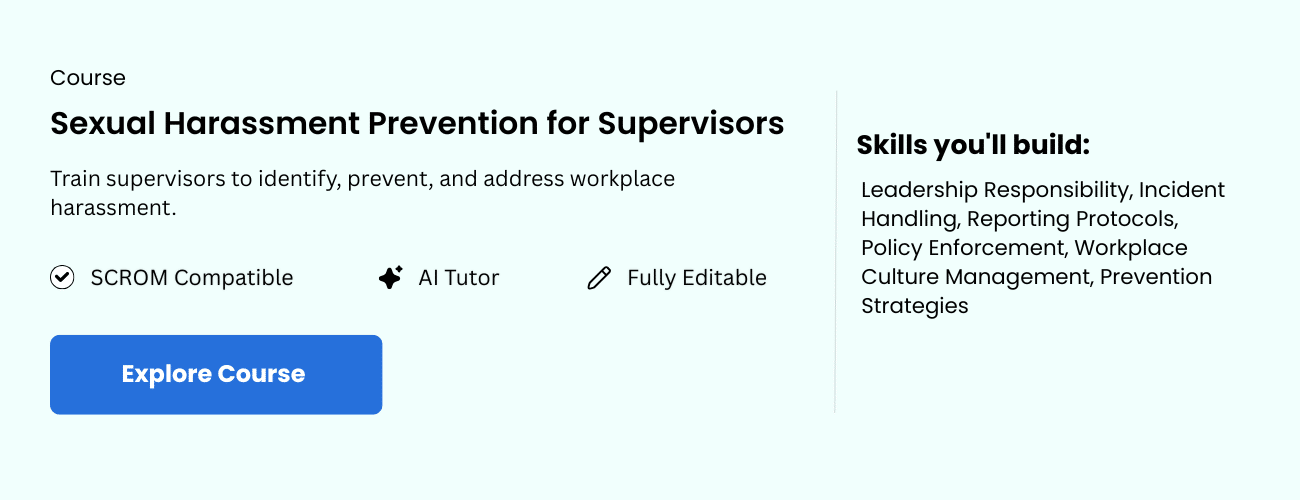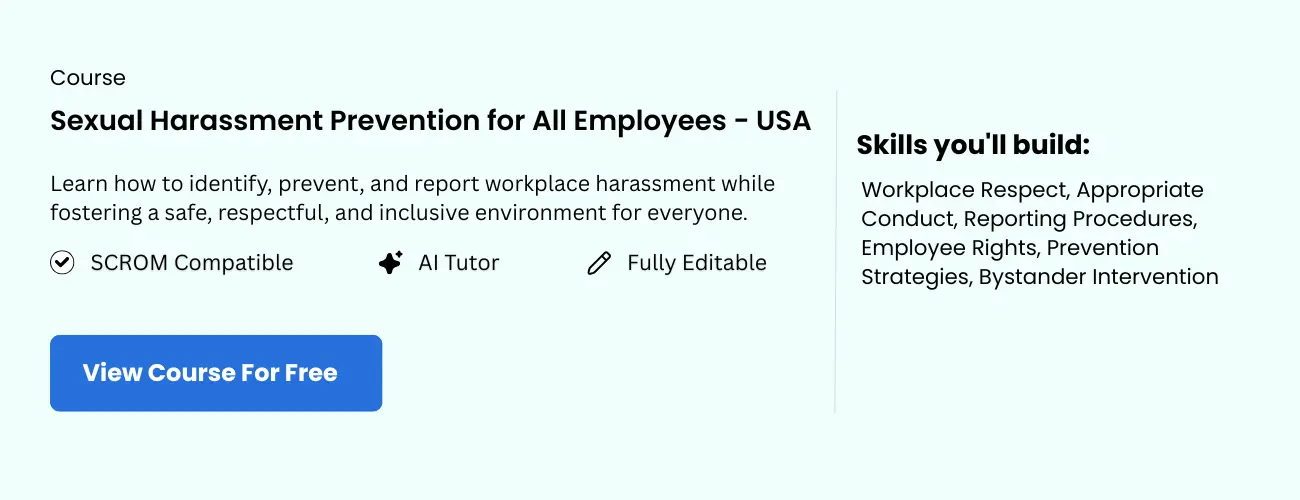Understanding Illinois Sexual Harassment Laws and Regulations
Addressing sexual harassment in the workplace is vital for creating a safe, respectful, and inclusive environment for all employees. Illinois has established one of the nation’s strongest legal frameworks to ensure Sexual Harassment Prevention for All Employees, emphasizing mandatory training, clear definitions, and strict employer responsibilities.
Legal compliance not only protects individuals but also strengthens organizational culture, enhances trust, and reduces legal and financial risks for employers. Under the Illinois Human Rights Act (IHRA) and the Workplace Transparency Act (WTA), employers are required to provide annual sexual harassment prevention training, maintain transparent policies, and enforce effective reporting mechanisms.
This section offers a comprehensive overview of Illinois’s regulatory landscape, highlighting key statutes, definitions of misconduct, training mandates, and employer obligations essential for building effective prevention strategies and ensuring full compliance across organizations.
Legal Foundations of Sexual Harassment Laws in Illinois
Illinois’s approach to sexual harassment combines federal and state statutes. The cornerstone federal law, Title VII of the Civil Rights Act of 1964, prohibits discrimination based on sex, which courts interpret to include sexual harassment. Illinois law complements this through statutes like the Illinois Human Rights Act (IHRA), which explicitly addresses workplace harassment and safety.
The Illinois Human Rights Act (775 ILCS 5/1-101 et seq.) provides protections against sexual harassment across workplaces, education sectors, and public settings. It empowers victims with avenues for remedies through the Illinois Human Rights Commission (IHRC) or courts, emphasizing the need for proactive policies and training programs.
Scope of Coverage: Who Must Comply?
Illinois laws apply broadly, ensuring all workplaces adhere to prevention standards. The IHRA covers:
- Employers with one or more employees
- State and local government agencies
- Educational institutions
- Contractors and subcontractors working with government entities
This wide scope reinforces Illinois’s commitment to a safe work environment, regardless of organization size or sector.
Key Definitions and Legal Concepts
Understanding terminology is crucial for compliance. Illinois law defines sexual harassment as unwelcome conduct of a sexual nature that affects employment or creates a hostile environment. It includes verbal, physical, and written conduct.
The law recognizes two primary types:
- Quid Pro Quo: When job benefits depend on submission to sexual advances.
- Hostile Work Environment: When pervasive conduct undermines work performance or creates intimidation.
Clarity on these definitions helps employers identify and address incidents proactively, aligning with Illinois legal standards.
Compliance and Training Mandates
Illinois law requires employers to conduct effective sexual harassment training for all employees, including supervisors. Key elements include:
- Definitions and examples of harassment under Illinois law
- Reporting and investigation procedures
- Legal rights and protections for victims
- Fostering a respectful workplace environment
Compliance minimizes legal risks and promotes a workplace culture rooted in awareness and accountability.
Illinois Sexual Harassment Training Requirements – In-Depth
Understanding Illinois’s specific obligations about harassment prevention training is essential for compliance. This section details training duration, content, delivery methods, and recent legislative updates to help your organization remain compliant with state law.
Overview of Illinois Sexual Harassment Training Mandates
Illinois law mandates comprehensive sexual harassment prevention training for all employees, including managers and supervisors. Proper training cultivates a harassment-free workplace aligned with Illinois’s commitment to experience, expertise, authority, and trustworthiness (E-E-A-T).
Training Duration and Content
Minimum Duration Requirements
All new hires and promoted employees must receive at least one hour of harassment training. Larger organizations are encouraged to administer extended or additional sessions, especially for supervisory staff, to deepen understanding of prevention and response roles.
Required Content Topics
Training programs must include the following:
- Definitions and real-life examples of sexual harassment under Illinois law
- Internal reporting and investigation procedures
- Employees’ rights and responsibilities
- The importance of maintaining a harassment-free environment
- Procedures for reporting incidents
- Disciplinary consequences of violations
- Bystander intervention and respectful communication
Delivery Methods and Accessibility
Approved Delivery Options
Employers can fulfill training requirements through various methods such as:
- In-person workshops with qualified trainers
- Interactive online modules with assessments
- Live or recorded webinars
Ensuring Accessibility and Inclusivity
Training must accommodate employees with disabilities, in compliance with the Americans with Disabilities Act (ADA). Materials should be available in multiple formats, and accommodations should be provided as necessary.
Recent Legal Updates and Amendments
Key Changes and Clarifications
- Supervisory personnel are now required to undergo specialized training focusing on their unique responsibilities and legal liabilities.
- Employers must keep records of all training sessions, including attendance logs and materials, for at least five years.
- Many organizations are opting for annual refresher training to reinforce policies and cover legal updates.
Legal and Cultural Impacts
Proactive training is emphasized by the Illinois Human Rights Commission as a critical tool to reduce harassment incidents and foster a respectful work environment. Demonstrating compliance through thorough recordkeeping and ongoing education is essential.

Best Practices for Implementing Effective Sexual Harassment Training
Developing impactful training programs is vital for cultivating respectful and safe workplaces. Effective initiatives educate staff on inappropriate behaviors, legal obligations, and foster a culture of accountability and respect. Here are strategies to ensure your training is engaging, measurable, and fosters cultural change.
1. Designing Engaging and Interactive Training Content
Address employee engagement by moving beyond traditional lecture methods. Incorporate scenarios, role-playing, multimedia resources like videos and infographics, and quizzes. Interactive platforms, such as e-learning modules with simulated responses, promote better retention and empathy.
Research shows participatory training reduces incidents of harassment and enhances workplace inclusion. The EEOC endorses engaging training as a key factor in behavioral change and risk reduction.
2. Measuring Training Effectiveness
Establish clear, measurable goals such as increased incident reporting, decreased complaints, or improved workplace civility. Use pre- and post-training assessments to gauge knowledge gains and conduct anonymous surveys for honest feedback on cultural improvements.
Long-term tracking of reports or workplace surveys provides insight into behavioral changes and program success. Confidential feedback channels encourage honest responses and continuous improvement.
3. Cultivating a Respectful Workplace Culture
Training must be part of a broader cultural commitment. Leadership should demonstrate commitment through policy enforcement and modeling respectful behaviors. Topics like bystander intervention, inclusive communication, and psychological safety reinforce this culture.
Ongoing initiatives, such as peer-led programs and open forums, encourage dialogue and accountability. Organizations committed to diversity and inclusion often see fewer harassment complaints.
4. Highlighting Successful Compliance and Cultural Initiatives
Share stories of departments or teams that exemplify respectful conduct. Recognize compliance milestones and effective resolution stories to reinforce positive behaviors and organizational commitment.
Utilize resources from the Department of Labor (DOL) and EEOC for best practices and case studies. Transparent reporting on training completion and incident metrics demonstrates proactive engagement and builds employee trust.
Thoughtfully implementing these practices transforms training from a regulatory requirement into a catalyst for cultural change, fostering workplaces where dignity and respect thrive.
Conclusion and Actionable Takeaways
Ensuring a safe, respectful workplace boosts productivity, employee loyalty, and organizational reputation. This guide emphasizes understanding harassment, establishing robust policies, and fostering a culture of respect.
Key Points Recap
- Recognize harassment: Identify various forms, including sexual, racial, and age-related misconduct, for early intervention.
- Legal compliance: Follow federal laws like Title VII and EEOC guidelines that mandate prevention measures.
- Clear policies: Develop comprehensive policies with defined reporting procedures.
- Ongoing training: Offer regular, effective training to sustain awareness and zero-tolerance policies.
Guidance for Ensuring Legal Compliance
- Review and update harassment policies regularly.
- Implement ongoing, evidence-based training tailored to your workforce.
- Create accessible reporting channels with protection against retaliation.
- Maintain detailed records of complaints, investigations, and corrective actions.
Next Steps for Employers
- Assess your current harassment prevention efforts and identify gaps.
- Consult legal experts to update policies and reduce liability.
- Promote diversity and inclusion initiatives to prevent harassment.
- Stay informed about legal updates through reputable sources like EEOC updates and HR associations.
Proactive measures not only ensure compliance but also demonstrate your commitment to safeguarding employees. Regularly reviewing, educating, and reinforcing respect and accountability fosters a workplace where dignity prevails.













